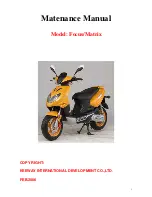
1
Use the valve extender
located in the end of the
right handlebar grip.
2
Open the round cover
located on the chain cover
by sliding the cover upward.
Align the opening in the drive
sprocket with the valve stem.
Thread the valve extender
completely onto the valve stem
and attach the pump. Inflate
to the PSI indicated on the tire
sidewall.
3
Remove valve extender
immediately after inflating and
close the round cover.
q
Inflating the Tires
Tires are inflated when shipped, but they invariably lose some pressure between the point of
manufacturing and your purchase.
Always inflate tires to the correct PSI before first time use.
Rear Tire
4
Using a bicycle style tire pump
equipped for a Schrader-type
valve, inflate the front tire to the
PSI indicated on the sidewall of
the tire.
WARNING:
Failure
to remove the valve extender
after inflating will cause the
inner tube and/or adapter to
be severed by the rear drive
sprocket.
Note:
If you lose the valve
extender, contact customer
service or one can be purchased
at almost any auto parts store.
WARNING:
Do not over inflate, as this
could damage tire or wheel.
Note:
The pressurized air
supplies found at gasoline
stations are designed to inflate
high-volume automobile tires.
If you decide to use such an air
supply to inflate your electric
scooter tires, first make sure
the pressure gauge is working,
then use very short bursts to
inflate to the correct PSI. If you
inadvertently over-inflate the
tire, release the excess pressure
immediately.
Front Tire
q
Attaching the Handlebars
Tools required:
5 mm Allen wrench.
2
With the front wheel
pointed straight ahead and the
handlebars square to the front
wheel, tighten the clamp as
shown.Tighten securely.
1
Loosen the collar clamp and
slide it upward. With a twisting
motion, push and twist to slide
the steering tube onto the fork.
Note:
Make sure the cables/
wires are out of the way before
inserting the stem in the fork.
WARNING:
Failure to
properly tighten the collar clamp
may allow the handlebars to
dislodge while riding and may
cause you to lose control and
fall. When correctly tightened,
the handlebars will not rotate
out of alignment with the
front wheel under normal
circumstances.
Note:
The cable and wire
assembly from the handlebar
must not wrap around the
steering tube or handlebar.
Sharp bends or twisting of
the brake cable can cause the
brakes to malfunction.
ASSEMBLY AND SET-UP































